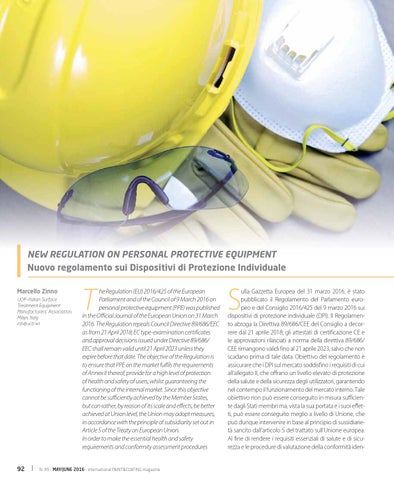NEW REGULATION ON PERSONAL PROTECTIVE EQUIPMENT Nuovo regolamento sui Dispositivi di Protezione Individuale Marcello Zinno UCIF-Italian Surface Treatment Equipment Manufacturers’ Association, Milan, Italy info@ucif.net
92
T
he Regulation (EU) 2016/425 of the European Parliament and of the Council of 9 March 2016 on personal protective equipment (PPE) was published in the Official Journal of the European Union on 31 March 2016. The Regulation repeals Council Directive 89/686/EEC as from 21 April 2018; EC type-examination certificates and approval decisions issued under Directive 89/686/ EEC shall remain valid until 21 April 2023 unless they expire before that date. The objective of the Regulation is to ensure that PPE on the market fulfils the requirements of Annex II thereof, provide for a high level of protection of health and safety of users, whilst guaranteeing the functioning of the internal market. Since this objective cannot be sufficiently achieved by the Member States, but can rather, by reason of its scale and effects, be better achieved at Union level, the Union may adopt measures, in accordance with the principle of subsidiarity set out in Article 5 of the Treaty on European Union. In order to make the essential health and safety requirements and conformity assessment procedures
N. 39 - MAY/JUNE 2016 - international PAINT&COATING magazine
S
ulla Gazzetta Europea del 31 marzo 2016, è stato pubblicato il Regolamento del Parlamento europeo e del Consiglio 2016/425 del 9 marzo 2016 sui dispositivi di protezione individuale (DPI). Il Regolamento abroga la Direttiva 89/686/CEE del Consiglio a decorrere dal 21 aprile 2018; gli attestati di certificazione CE e le approvazioni rilasciati a norma della direttiva 89/686/ CEE rimangono validi fino al 21 aprile 2023, salvo che non scadano prima di tale data. Obiettivo del regolamento è assicurare che i DPI sul mercato soddisfino i requisiti di cui all’allegato II, che offrano un livello elevato di protezione della salute e della sicurezza degli utilizzatori, garantendo nel contempo il funzionamento del mercato interno. Tale obiettivo non può essere conseguito in misura sufficiente dagli Stati membri ma, vista la sua portata e i suoi effetti, può essere conseguito meglio a livello di Unione, che può dunque intervenire in base al principio di sussidiarietà sancito dall’articolo 5 del trattato sull’Unione europea. Al fine di rendere i requisiti essenziali di salute e di sicurezza e le procedure di valutazione della conformità iden-
